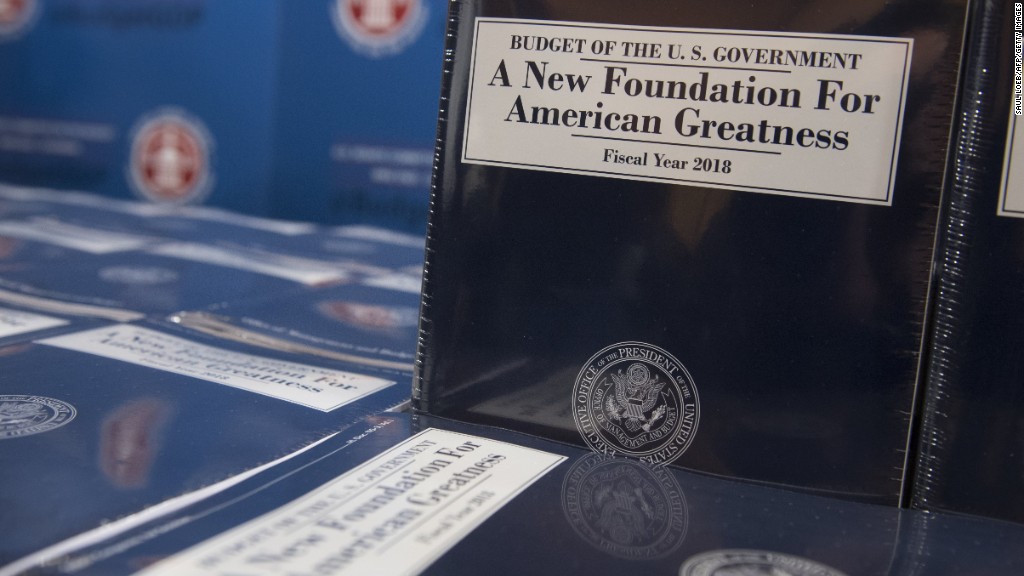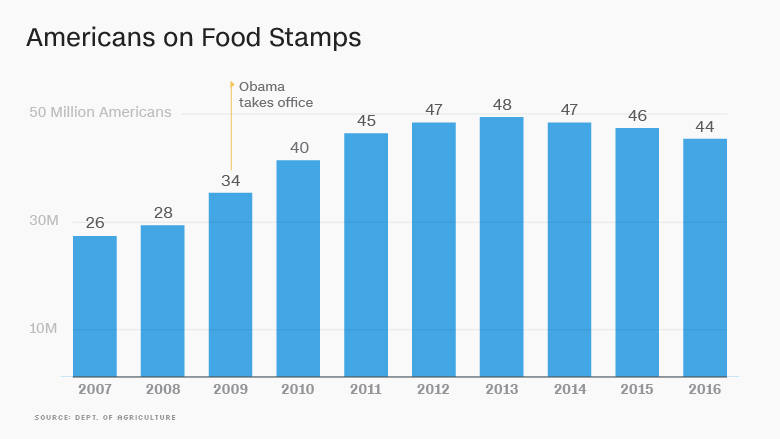
President Trump became famous for saying "You're fired." Now he wants to be known for saying, "You're hired!"
Trump appears to want at least 6 million Americans off government aid and into full-time jobs.
"If you're on food stamps and able-bodied, we need you to go to work," White House budget director Mick Mulvaney said Monday. The White House budget doesn't specify how many people it expects to leave government aid, but Mulvaney said several times that "in excess of 6 million people" should be able to get full-time jobs in the Trump economy.
The "welfare-to-work" push is critical to Trump's plan to attempt to balance the budget. He gets over $1 trillion in savings by scaling back the safety net.
Liberals call this cruel. Conservatives call it overdue. A lot of economists call it magical thinking, sprinkled with some fairy dust.
"We're essentially at full employment. I just don't think we'll move more people from government rolls to jobs," says economist Doug Holtz-Eakin, head of the American Action Forum and a former adviser to John McCain's presidential campaign.
"Full employment" is economic speak for the time when about everyone who can get a job already has one. The reality is America has had over 5.7 million job openings for months.
It sounds simple: Take those unemployed people and put them on the front door of companies seeking workers.
The problem is: Companies don't want these workers. Why? They don't have the skills to do those jobs.
Related: Trump's first budget: Trillions in cuts
Trump wants to cut job training programs
Business leaders complain constantly that people either don't have the right skills or that they're unwilling to move. So there might be a lot of job openings in places like Utah, but a lot of the unemployed are sitting in places like eastern Kentucky.
Most people think the solution is job training, but Trump's budget would slash those programs by 40%, according to an analysis by the left-leaning Center on Budget and Policy Priorities.
"If the Trump administration wanted to get more people working, they would invest in job training, help more people go to college and invest in childcare," says Sharon Parrott, a senior fellow at CBPP. "They are not doing any of these things."
The White House says instead of focusing on training programs, it's better to beef up the economy so businesses have no choice but to hire, train and relocate more people.
"Growth cures so many ills," Mulvaney said Wednesday when he testified before Congress. He insisted a healthy economy could absorb 6 million more workers.
Related: I voted for Trump. Now he wants to cut the aid I need
Trump is betting big on economic growth
The Trump team basically wants a repeat of the 1990s when the economy was humming, wages were rising, and a lot of single moms got off welfare and went to work.
"The fundamental issue here is sending people a check in the mail isn't helping them to a new job. In fact, it's paying them to stay stuck where they are," says Robert Rector, a senior fellow at the right-leaning Heritage Foundation who worked on the 1996 federal welfare reform.
The 1996 reform focused mainly on Temporary Assistance for Needy Families (TANF), the federal cash aid, otherwise known as "welfare checks."
Only 1.3 million families are on the TANF program now, down substantially from 3.7 million in 1997.
Rector argues it's time for a similar reform to the food stamp program, known as the Supplemental Nutrition Assistance Program (SNAP), although it's important to note that SNAP already requires that adults receiving the aid are also searching for a job.
About 44 million Americans are on SNAP today. Enrollment spiked during the Great Recession as people lost their jobs. It has come down a bit since, but it's still far higher than the 26 million who were in the program before the crisis hit.
Some of the growth has come from people who are working. They just don't earn enough to put enough food on the table for their families, get out of poverty and off government aid.

Related: Panicked student loan borrower: 'I've changed my life based on their promise'
Can Trump usher in another 1990s growth miracle?
So can the 1990s growth miracle happen again? The short answer is: It's unlikely.
This is a very different economy than in the 1990s.
The US has been stuck at about 2% growth a year as Baby Boomers age and productivity growth has mysteriously slowed. Unfortunately, the social media revolution hasn't been as great for the economy overall, as the early days of the internet.
Almost no one thinks Trump will be able to get the 3% growth that his budget assumes.
Even some Republicans are openly skeptical that Trump (or anyone else) can get the US back to 3% growth.
"This budget presumes a Goldilocks economy. ... I don't know how you get there," said Rep. Mark Sanford, a Republican from South Carolina. "For us to have a real debate, we have to base it on real numbers."


